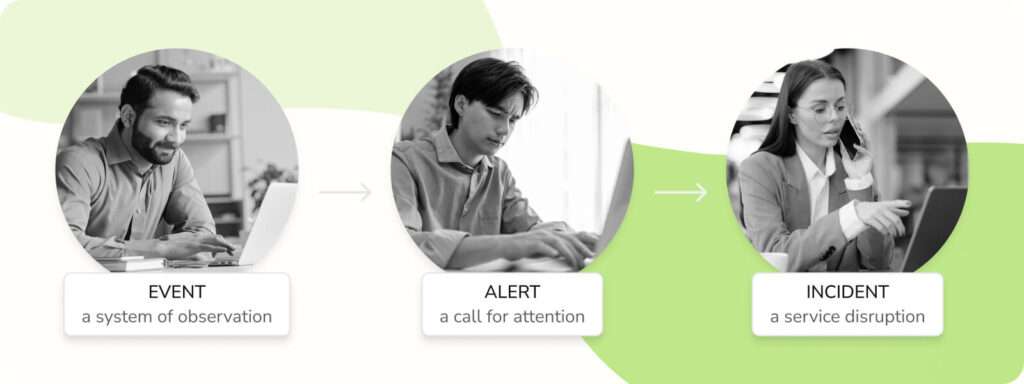Introduction to Incident vs Events in IT
Lack of clarity around key IT Service Management (ITSM) terminology can cause operational confusion and erroneous decisions. At enterprise scale, this often leads to wasted effort and missed opportunities. As such, the distinction between an incident vs. an event in ITSM, and AIOps isn’t just semantic. Its follow-on effects can tangibly impact the business.
Using the key terms incident and event interchangeably can cause harmless events to be escalated, while serious incidents go unchecked. What’s more, if you’re using any Agentic AI for ITSM, which nearly all next-gen ITSM platforms use, miscategorization can train your agents incorrectly, leading to less reliable outcomes.
The solution begins with ensuring your team understands and consistently applies the key differences between events and incidents. Once those definitions are clear and consistent, you should use Agentic AI solutions to respond to various inputs and autonomously categorize, route, and even resolve both kinds of tickets.
Core Concepts: Events, Incidents, and Alerts in IT Systems
Understanding the differences between incidents vs. events starts with a solid grasp of some core concepts:
What is an Event?
An event is any observable occurrence within an IT system, network, or service that has significance for its management; its effect can be either negative or positive.
What is an Alert?
An alert is a notification that a specific event (or series of events) has met a predefined threshold; it sometimes indicates a potential incident, but not always.
What is an Incident?
An incident is any event that disrupts or reduces the quality of an IT service; all incidents require an immediate response.
| Dimension | Event | Alert | Incident |
| What it is | Observable change/state | Notification that threshold/rules matched | Confirmed service impact |
| Typical Sources | Logs, metrics, traces | Monitoring/SIEM/AIOps | User reports + correlated alerts |
| Owner | NOC/SRE tools | On-call rotations | Incident commander + resolvers |
| KPIs | Volume, correlation rate | Noise ratio, dedupe %, MTTA | MTTD/MTTA/MTTR, downtime, SLA/SLO impact |
| Example | CPU = 55% | CPU >95% for 5m | Check-out API latency breach |

How an Event Escalates into an Incident
Events, alerts, and incidents progress linearly, each stage representing an escalation in risk and negative business impact. For example, consider how CPU usage progresses along these stages:
- Event: A server’s CPU usage reaches 55%. This doesn’t cross any threshold set by your IT team, so at this point it’s simply a monitored metric with no required response.
- Alert: The same server’s CPU usage spikes to 95%, crossing a predefined threshold. The IT team then receives an alert that the server may be under an unusual load.
- Incident: Sustained high CPU usage causes critical business applications to slow down, and users begin reporting disruptions to service. At this point, because the negative impact is confirmed and requires urgent attention and remediation, it’s considered an incident.
Let’s break down each of these stages in the escalation chain in more detail.
1. The Event: A System Observation
An event is simply a routine log entry or state change in your IT ecosystem. Most of the time, events represent normal operations and have no negative impact on the business. Other times, they represent potential incidents.
Generally, we can break events down into four categories:
- Informational events signify that normal operation is taking place—no action needed
- Warning events signify an unusual state that is either nearing or has surpassed a predetermined threshold. Warning events may or may not indicate a threat or potential incident, and may or may not trigger an alert.
- Exception events signify that a threshold has been breached or the service is deviating significantly from typical operations. These events require an immediate response, almost always trigger an alert, and likely will be escalated to an incident.
- Maintenance events are planned and scheduled activities, such as system upgrades or backups, designed to minimize disruption. They are communicated in advance and managed differently from unplanned incidents. Properly identifying maintenance events helps reduce unnecessary alerts and improves overall event management clarity.
2. The Alert: A Call for Attention
In an IT management context, an alert is precisely what it sounds like: an automated notification sent to IT teams when an event crosses a predetermined threshold. A typical IT system will log thousands of routine events daily, far more than anyone can manually review. Alerts cut through the noise and surface only the events in the system that could demand attention.
Sometimes, the alert doesn’t call attention to a systemwide problem; five failed login attempts in one minute could mean the user has forgotten their password. Other times, it indicates a critical error, like excessive memory usage that slows the system down for everyone.
Whatever the issue, alerts bring it to the IT team’s attention so they can decide the best course of action to address it.
3. The Incident: A Service Disruption
Incidents are alerts or a series of alerts with a confirmed negative business impact or disruption to IT service quality. In nearly all cases, incidents require immediate human attention. Most enterprise IT organizations will have formal response processes and escalation ladders for incidents.

Incident vs. Event in a Security Context
Everything we’ve discussed so far applies broadly to all IT segments. However, when an event or incident happens in a cybersecurity context, the stakes are much higher. Thus, it’s doubly important to understand the difference between incidents vs. events in this specific instance.
What is a Security Event?
A security event is any observable change in the expected behavior of a system or network that has potential security implications. Many security events are harmless, but the risk of a problem makes every one of them noteworthy. Examples include user access to sensitive files, a firewall blocking an unknown IP, or a user reporting that they’ve received a phishing email.
What is a Security Incident?
A security incident is an event that is a confirmed violation of security policies or an imminent threat to business confidentiality, integrity, or availability. Examples of security incidents run the gamut and include examples like confirmed malware infections, unauthorized user access, or credential theft from a phishing attack.
Managing the Lifecycle: Event and Incident Management
Effective ITSM requires two distinct approaches that tackle the problem from opposite directions. Most organizations start with a reactive approach, responding to incidents as they come in. While that’s important, it still puts your IT on the back foot. For complete coverage, you need to complement it with a proactive approach, monitoring events and addressing them before they escalate into incidents.
Incident Management: The Reactive Response
Incident management is crucial for business operations. Every second a service is disrupted is equal to lost productivity and revenue. The goal of incident management, then, is to restore operations as quickly as possible and minimize the business impact. Typically, this includes a formal process of identification, logging, categorization, prioritization, response, and resolution.
Event Management: The Proactive Approach
Typically, more organizations struggle with event management than incident management. That’s because for incident management, the immediate need and urgency are palpable. With event management, that’s not always the case.
Event management involves monitoring and filtering event data to catch potential issues early. In the best-case scenario, you can prevent them from escalating into incidents. Event management requires the use of monitoring tools that can detect, categorize, and correlate events and identify meaningful patterns and anomalies, often with the help of AI algorithms and agents.
SRE (Site Reliability Engineering) introduces additional reliability-focused concepts relevant to incident and event management:
- Service Level Indicators (SLIs), Service Level Objectives (SLOs), and Service Level Agreements (SLAs) guide teams in measuring and maintaining service reliability.
- Error budgets help balance the risk of incidents against release velocity, ensuring controlled service risk exposure.
- The practice of blameless postmortems encourages learning from incidents without blame to improve system reliability continuously.
Incorporating SRE principles into IT operation management (ITOM) enhances proactive event processing and structured incident response focused on measurable service reliability.
The Human Factor: How to Avoid Alert Fatigue
Both incident and event management provide IT teams with the information they need to resolve and prevent incidents. But if those teams are so overwhelmed with alerts that they’re desensitized to them, a phenomenon known as alert fatigue, they could miss critical notifications that require urgent attention.
Setting up alert monitoring with this human factor in mind is essential. Some options include:
- Deploy machine learning and agentic AI to automatically prioritize and triage alerts, focusing only on the most critical issues
- Use deduplication and suppression windows to eliminate repetitive alerts and reduce noise
- Apply dynamic thresholds and seasonality adjustments to tailor alert sensitivity based on context
- Link alerts to relevant runbooks to streamline troubleshooting and resolution
- Correlate related events into unified alerts to avoid multiple notifications for the same issue
- Configure alerts to reach the appropriate IT staff or 24/7 NOC efficiently
Best Practices for Integrated Management in IT Operations
The process we’ve discussed so far only works when two conditions are met: 1) the procedures and escalation ladders around events, alerts, and incidents are clearly defined, and 2) those procedures are consistently applied by both human personnel and AI agents.
To that end, here are some best practices for integrating teams, platforms, and agents around efficient event and incident management, enabled and enhanced by Aisera’s autonomous AI capabilities.
1. Establish a Clear Response Plan
First, create a documented plan to define the roles, responsibilities, and procedures for when an incident occurs. Response plans include severity levels, escalation paths, communication protocols, and each team’s responsibility, including stakeholders and leadership, in resolving the issue.
A clear response plan helps prevent confusion during a high-pressure situation and ensures a speedy, coordinated response.
2. Prioritize Responses by Business Impact
It’s crucial to prioritize incident responses based on impact on the business, not just technical symptoms. For example, a broken payment portal is more urgent than a slow-running internal report.
Regardless of which prioritization logic you use, incident severity matrix, impact/urgency grid, or service-level classifications, it’s important to structure them so you’re deploying resources to ensure business continuity and mission-critical functionality. It’s equally important for IT teams to regularly revisit these criteria as business needs and customer expectations continue to evolve
3. Automate and Integrate Your Tools
The sheer volume of events and alerts IT teams face daily makes manual handling impossible. Leveraging Aisera’s agentic AI platform automates detection, logging, and routing with precision, driving up to a 70% reduction in Mean Time to Resolution (MTTR) through automated root cause analysis and proactive incident response.
By delivering auto-resolution rates as high as 81%, Aisera drastically cuts tickets requiring manual intervention, freeing IT staff to focus on critical, higher-value work.
Additionally, customers report up to 90% cost savings and 50% productivity improvements by automating routine tasks, deflecting tickets, and enabling user self-service. This integrated automation accelerates response times, reduces operational overhead, and creates a seamless, scalable ecosystem for incident management.
4. Conduct Post-Incident Reviews
After your team resolves the incident, it’s a good idea to conduct a blameless retrospective while the incident is still fresh in everyone’s mind. Leveraging insights and knowledge automation from Aisera’s Agentic AI, organizations can turn every incident into a learning opportunity, maintaining accountability without finger-pointing and preserving psychological safety.
These learnings feed back into internal knowledge bases powered by AI agents to accelerate future incident identification and resolution, driving continual process improvement and smarter IT operations
5. Proactive Incident Prevention
Advanced AIOps platform capabilities enable IT teams to anticipate and mitigate incidents by predicting potential outages in advance. By analyzing telemetry, tickets, logs, and events in real time, organizations can receive early alerts to address vulnerabilities before they escalate, improving system reliability and ensuring uninterrupted business operations.
This proactive approach helps shift IT management from reactive incident response to predictive, preventive practices. Solutions like Aisera exemplify how AI-driven insights can empower teams to proactively prevent incidents.
Final Thoughts on Incidents vs. Events
While automated monitoring and alerts are common in modern incident management, autonomous agentic resolution is less so. Many organizations assume that AI agents are less effective at resolving issues than a human IT professional.
However, numerous routine incidents are within AI’s ability to handle autonomously. Aisera’s purpose-built AI agents are trained to understand enterprise objectives and context, delivering intelligent, autonomous resolution with minimal human input.
Aisera’s unified agentic AI platform is uniquely designed to orchestrate these autonomous operations, connecting AI agents seamlessly across tools and workflows. This approach transforms incident management from reactive firefighting to proactive, intelligent, and scalable IT operations that boost productivity, reduce downtime, and lower operational costs.
Learn more about how Aisera’s enterprise agentic AI platform reinvents incident management to empower your IT teams and drive superior business outcomes.

